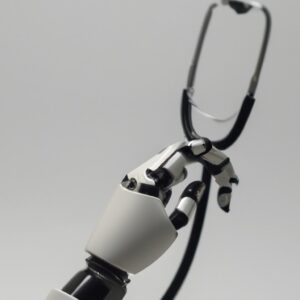Look to the Future: Unanticipated Uses of Augmented Reality”

Introduction to Augmented Reality and its Potential Applications
Augmented Reality (AR) is a new technology that has the potential to revolutionize the way we interact with our environment. In AR, digital objects are ‘augmented’ into the real world and users are able to interact with them. AR applications can be used in various industries, from gaming to health care and entertainment. It is considered to be a game changer as it provides an immersive experience that is more engaging and interactive than traditional technologies.
The potential of augmented reality applications is far-reaching. Currently under development are applications that can enrich business operations, gaming, education, healthcare, entertainment, and more. AR applications are being used to visualize current information in a 3D setting, facilitate virtual meetings, and even enable hands-free operating of machinery. Some of the potential applications of AR include:
- Interactive learning experiences, enabling students to learn and explore their surroundings in a more engaging way.
- The ability to create virtual prototypes of products without requiring physical prototypes.
- Integration of augmented reality with the internet of things (IoT), which will enable users to interact with connected devices in a more immersive way.
- Enhanced navigation, to assist people in finding their destination quickly and accurately.
- Augmented reality shopping and retail experiences, allowing customers to virtually ‘try on’ products without requiring trips to physical stores.
- Collaboration tools, allowing remote teams to work together on projects in 3D, interactive settings.
As the technology develops and becomes more accessible, more opportunities for innovative applications of AR will emerge. While the opportunities are exciting, it’s important to note that there are some challenges associated with developing and deploying AR applications. We will explore these challenges further in the guide.
Analyzing the Current Trends in Augmented Reality
Augmented reality (AR) is a technology that merges digital objects with the physical world. It is being used by businesses, educators, and developers to build interactive experiences. Nearly every industry is leveraging the power of AR, from interactive maps in mobile apps to immersive learning experiences.
Recent years have seen an influx of products and services in the AR space. Companies such as Google and Apple have introduced AR powered products, not limited to the gaming industry. From education and healthcare, to retail and entertainment, there is potential for AR to revolutionize most sectors.
The key trends in Augmented Reality are as follows:
- Growth of cloud-based platforms – Cloud-based AR platforms such as Amazon Sumerian are allowing developers to build more immersive content without having to invest in hardware or software.
- New input methods – Advances in AR input methods such as gesture recognition and voice assistants are helping users interact with AR content in a more natural way.
- Augmented Reality Aided Design – AR is being used to help designers visualize how products would look when assembled. For example, Ikea Place allows customers to “try out” furnishings before buying them.
- Automation of AR development – Companies such as 6d.ai are offering automated tools to help developers create AR content quicker and more efficiently.
- Cross-platform frameworks – Frameworks such as Apple’s ARKit and Google’s ARCore are providing a standard platform for developers to create AR content that can be accessed on multiple devices.
These new trends are paving the way for the future of AR applications and helping companies create more immersive experiences for their customers.
Reviewing the Market Landscape for Augmented Reality Applications
Augmented reality (AR) has become a key player in the digital marketplace. As technology advances, it’s becoming increasingly available to businesses, consumers, and everyone in between. The AR industry continues to evolve, with new applications being developed and released at rapid speeds.
The AR market is fragmented and is composed of various types of products and services. There are a range of AR hardware and software solutions, from expensive headsets to smartphone apps. AR tools are used by a variety of industries, from entertainment to healthcare.
Businesses have an opportunity to take advantage of AR for a variety of applications. This includes creating interactive experiences for customers, providing product information, or delivering virtual training courses. Companies can also leverage AR to enhance customer service, improve efficiency, and reduce costs.
While AR has been around for some time, there are still many challenges in developing applications. Companies need to ensure the aesthetics and functionality of their AR solutions are up to standards. Additionally, due to the fragmentation of the market, it can be difficult to find the right partners and resources to develop and deploy AR apps.
While there is still much to learn and discover about AR applications, there is no doubt that the technology is set to be a major player in the future. With advancements in hardware and software, businesses will have unprecedented opportunities to take advantage of AR.
Future Use Cases of Augmented Reality
Augmented reality (AR) technology has the potential to revolutionize modern life. It is already being used in various businesses, from education and healthcare to entertainment and marketing. In the near future, augmented reality will be used for a wide range of applications. Some potential uses include enhancing physical objects by adding digital information, real-time navigation and environmental feedback, smart home automation, remote collaboration, virtual retail experiences, and more.
One of the most exciting use cases of augmented reality is its potential to offer immersive learning experiences. This could involve virtual field trips, reduced-scale simulations, and holographic displays of 3D objects. AR learning experiences could provide students with hands-on experiences and give them the opportunity to “travel” to different places without ever leaving their classrooms. AR can also be used to create personalized learning experiences for individual students based on their interests and abilities.
Augmented reality can also be used to improve transportation and navigation. AR can provide real-time traffic and navigation updates, as well as 3D visualizations of roadways and landmarks. This would help drivers find their destinations more quickly and reduce the amount of time spent searching for parking spots. In the future, it is possible that AR could be used to assist in self-driving cars, providing the vehicle with additional data about its surroundings.
AR could also be seamlessly integrated into the home environment, making it easier to control appliances and devices. Augmented reality could be used to display information such as the current temperature, view calendars, access news and weather reports, and monitor security cameras. With voice commands, users could easily control lighting levels, air conditioning settings, and even their television sets.
Finally, virtual and augmented reality could be used to create immersive retail experiences. Consumers could browse stores remotely and try on clothes, furnishings, and other items without ever leaving their homes. AR could also be used to create interactive experiences at physical retail stores, such as product displays activated by movement or voice commands.
The potential applications of augmented reality are limited only by our imagination. As technology continues to advance, the use cases for AR will only continue to expand. Augmented reality has the potential to transform every aspect of our lives.
Outline Challenges in Developing Augmented Reality Applications
Creating augmented reality applications poses many challenges. Developers must consider the complexity of the technology, an unpredictable user base, and ethical considerations when building these applications. It’s also important to consider how artificial intelligence can be utilized to maximize the potential of AR applications.
One of the biggest challenges is creating software that works for a wide variety of devices. Many AR applications require special sensors and powerful processors to work correctly. This can lead to compatibility issues with certain hardware or operating systems. Additionally, developers must account for quick changes in technology as technologies evolve.
Designing an effective user interface is also a challenge. AR applications often require users to interact with the screen in order to access features. As such, user experience needs to be a priority when designing an AR application.
From an ethical standpoint, developers need to consider how their applications may impact users. There is a potential for data collection without users’ knowledge, as well as privacy concerns. Additionally, there is the potential for misuse of AR technology, especially if used for manipulative or surveillance purposes.
Lastly, developers should be aware of the potential use of artificial intelligence in augmented reality applications. AI has the potential to enhance user experience by collecting data about user preferences and making suggestions based on that data. However, there are potential ethical implications with this technology that developers must consider.
Tools and Technologies for Augmented Reality Development
Building augmented reality (AR) applications can be a complex process. It requires strong programming skills, a good understanding of software architecture, and a thorough knowledge of the latest technologies. Advances in technologies have made it easier for developers to create immersive and engaging experiences with AR. In this section, we will explore the various tools and technologies available to help developers build AR applications quickly and efficiently.
Programming Languages
The most popular programming language used for AR development is currently C#. It is an object-oriented language which allows developers to easily create more complex applications. Other languages such as Java, Python, and JavaScript are also commonly used. Knowing at least one of these languages is essential for AR development.
3D Modelling Software
3D modelling software is used to create 3D objects and environments that can be viewed in augmented reality. Popular software includes Autodesk Maya, Blender, and SketchUp Pro. These packages are typically used by experienced 3D artists to create realistic models.
AR Frameworks and Platforms
AR frameworks provide the foundation for developing augmented reality apps. Popular libraries such as Apple ARKit, Google ARCore, Vuforia, and Microsoft HoloLens are widely used for developing apps on mobile devices, desktops, and smart glasses. For cross-platform projects, Unity 3D and Unreal Engine are great options.
Computer Vision and Tracking Libraries
Computer vision and tracking libraries enable developers to track objects, recognize faces, detect patterns, and analyze images in AR projects. Popular libraries include OpenCV, Dlib, and scikit-learn. These libraries provide powerful tools for analyzing images and recognizing objects in augmented reality.
Debugging and Testing
Debugging and testing are essential components of any software project. Good debugging and testing tools are necessary to identify and fix bugs before they become costly problems. Popular tools include JIRA, Visual Studio, and Xcode. These tools allow developers to quickly locate and fix issues in their AR applications.
Scenarios for Developing and Deploying Augmented Reality Applications
Augmented reality (AR) applications are becoming increasingly commonplace. As such, it is important to consider potential scenarios for developing and deploying AR applications. There are three scenarios to consider depending on how complex the AR application is and the resources available.
- QuickLaunch: This scenario requires low cost and effort to develop and deploy. It is ideal for basic tasks where the goal is to quickly add simple AR features.
- FullScale Development: This is a more complex project with multiple stakeholders, teams, and a longer timeline. It is best for tasks requiring a higher degree of interaction, detailed visualizations, and complex analytics.
- Hybrid Approach: This model combines the QuickLaunch and FullScale models to maximize cost efficiency and speed of development and deployment. It is best for complex projects with varying levels of complexity.
Each approach has its own set of advantages and disadvantages, but an understanding of these three approaches can help inform how you decide to develop and deploy AR applications.
Investing in Augmented Reality Technologies: Opportunities and Risks
When it comes to investing in augmented reality (AR) technologies, there are both opportunities and risks. Before deciding whether or not to invest in AR technologies, it is important to understand the potential opportunities and risks associated with such investments.
One of the biggest advantages of investing in AR technologies is that investors can benefit from the potential of disruptive innovation. AR technology has the potential to revolutionize how we interact with the physical world, offering a wide range of applications. Investing in AR technologies can potentially open up new markets and create opportunities for business growth.
On the other hand, investing in AR technology also comes with its own set of risks. For example, as a relatively new technology, there is no guarantee that any investment will yield the desired results. In addition, some of the applications of AR technology may not be accepted by the public, resulting in a waste of resources. Furthermore, since the technology is still being developed, there is a risk that an investment could become obsolete if the technology advances before it reaches the market.
Overall, investing in AR technologies can be a great opportunity for some investors, but before jumping in it is important to understand the potential risks. It is important to carefully consider all of the factors before deciding whether or not to invest in AR technologies.
The Impact of Augmented Reality Applications on Businesses and Markets
Augmented reality (AR) applications are making a big impact on businesses and markets. Not only do they provide an exciting way to interact with customers, but these applications also provide useful data that helps companies make informed decisions about their markets. By using innovative features like 3D mapping and object recognition, AR applications can bring real-world data to life.
These applications can help businesses gain a better understanding of customer behavior and buying patterns. Companies can use this data to adjust the pricing of products and services, test the effectiveness of marketing campaigns, and identify new target markets. Additionally, AR technologies can be used to create immersive shopping experiences, allowing customers to “try before they buy.” For example, some companies are using AR applications to allow customers to virtually try on clothes before buying them.
Furthermore, AR applications can help businesses reduce costs by automating certain processes. For instance, AR can be used to streamline inventory management by providing real-time updates on stock levels, enabling businesses to order supplies more efficiently. Additionally, AR can help reduce physical waste by digitizing documentation and eliminating the need for printed materials. Finally, AR applications can help businesses increase efficiency by providing access to information in a more efficient manner.
In addition to helping businesses, AR applications are also making an impact on markets. They can provide real-time insights into market trends and customer preferences, enabling businesses to make more informed decisions. AR technology can also be used to boost brand visibility and generate interest in products and services. Finally, AR applications can be used to provide immersive experiences for customers, which can drive sales and loyalty.
Overall, augmented reality applications are having a major impact on businesses and markets. The technology is revolutionizing the way companies operate and giving them unprecedented insights into their target markets. As this technology continues to develop, businesses and markets will be able to leverage its powerful features to their advantage.
Examining Ethical Concerns of Augmented Reality Applications
Augmented reality (AR) is a technology that blends virtual reality with the physical environment. It has many potential applications, ranging from mapping and navigation to gaming and entertainment. While AR offers countless potential benefits, there are also important ethical considerations.
One of the most pressing ethical concerns associated with augmented reality is privacy. Because AR apps rely on real-time data, they can allow companies to track users’ movements, locations, and behavior. Companies may use this information to target users with specific ads or promotions, without their consent. This could lead to an invasion of user privacy, and even profiling.
Another ethical concern is data security. AR apps can collect massive amounts of data, which can then be vulnerable to cyber-attacks, leaks, or misuse. The security of this sensitive data must be safeguarded, as it could be used for nefarious purposes.
The potential for bias and discrimination is another ethical concern associated with augmented reality. AR algorithms can often be trained using biased data sets. As a result, they may lead to unfair or discriminatory decisions, such as in facial recognition systems. It is important to ensure that AR algorithms are unbiased and respect users’ rights.
Finally, the monetization of AR apps is an ethical concern. Many AR apps are free to download, but they may require users to pay for certain features or services. This presents potential problems, as some prices may be too high for certain users. Additionally, companies may use unfair tactics, such as in-app purchases or aggressive advertising, to monetize their apps.
Overall, augmented reality has tremendous potential, but it is important to consider the ethical implications of its applications. Developers must ensure that their apps comply with laws and regulations, respect users’ privacy, and are free from bias or unfair monetization strategies.
The Future of Augmented Reality Applications
Augmented Reality (AR) is a technology that superimposes a digital layer of images, sound and other media over our real-world environment. It has huge potential for use in many different industries such as healthcare, education, retail, entertainment and many more. AR apps can help people observe objects within their environment in a more immersive way and it also enhances the user experience.
The potential for AR applications is limitless; we are just beginning to tap into it. AR has already made a significant impact on the market, with its adoption in various fields. According to many experts, this trend is set to continue and even accelerate in the coming years.
In the future, AR applications will be used more extensively in education, entertainment, and other areas of life. For instance, with AR technology it would be possible to create virtual museums, where students can learn about the history of certain places or events in a much more interactive way. AR can also enable interactive gaming experiences, making it easier for people to explore and interact with their surroundings. Additionally, AR applications offer a huge potential for businesses, as they can provide customers with immersive experiences and better customer service.
To develop successful AR applications, developers need a wide range of tools and technologies. These include 3D graphics engines, motion tracking systems, voice recognition, computer vision algorithms, and many more. In the future, these tools and technologies will become even more advanced and robust, enabling developers to create complex and sophisticated AR applications.
Developers must also take into account the ethical implications of AR applications. With AR technology, people can be exposed to biased information or manipulated experiences depending on who developed the application. Thus, developers should take all necessary measures to ensure that AR applications are safe and respect privacy and ethical boundaries.
Overall, the future of AR applications looks very promising. There is a huge potential for innovation in this field, and these applications have the potential to make a significant impact on many aspects of our lives. AR technology will continue to evolve, and developers will have to keep up with the latest trends and technologies to stay ahead of the curve.
Conclusion
Augmented reality is a rapidly emerging technology that has the potential to transform the way we interact with computers. It is likely to become a mainstream technology in the near future. As such, it is important to understand the current trends and advancements in the field to foresee the most promising applications of this technology. However, AR also presents a host of ethical concerns that must be addressed and considered when developing and deploying AR applications.
It is clear that there are numerous opportunities which arise with augmented reality, both for businesses and individuals, and these should be taken full advantage of. Additionally, investments into AR technologies could reap rewards for those willing to take the risk. In conclusion, it is likely that AR will transform the digital landscape in coming years in ways that we can only imagine.
comments: 0






